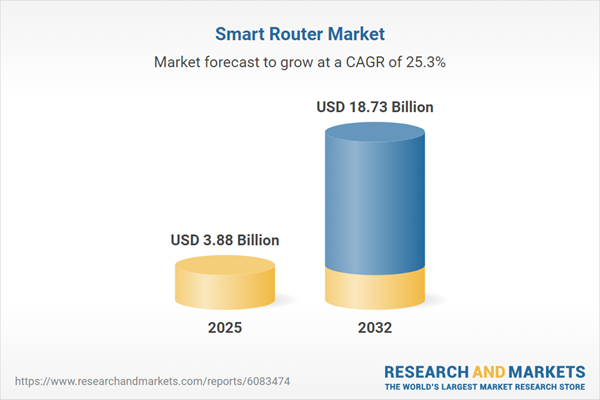Speak directly to the analyst to clarify any post sales queries you may have.
The smart router market is undergoing significant transformation, emerging as a critical enabler of next-generation connectivity and robust network infrastructures for enterprises and consumers. As technology paradigms shift and digital ecosystems expand, understanding this sector's foundational drivers is vital for informed leadership decisions.
Market Snapshot: Smart Router Market Size & Growth
The Smart Router Market grew from USD 3.08 billion in 2024 to USD 3.88 billion in 2025 and is forecast to maintain a compound annual growth rate (CAGR) of 25.27%, reaching USD 18.73 billion by 2032.
Scope & Segmentation
This comprehensive report assesses the Smart Router Market across critical dimensions, segments, and geographies. Decision-makers gain visibility into current and emerging trends shaping the market landscape.
- Component: Hardware, Services, Software
- Router Type: Mesh Router, Outdoor Router, Standard Router (Dual Band, Single Band, Tri Band)
- Application: Broadband Access, Hospitality Networking, Office Networking, Smart Home Connectivity
- Distribution Channel: Offline Retail, Online Retail
- End User: Commercial, Industrial, Residential, Service Provider
- Region: Americas (United States, Canada, Mexico, Brazil, Argentina, Chile, Colombia, Peru), Europe, Middle East & Africa (United Kingdom, Germany, France, Russia, Italy, Spain, Netherlands, Sweden, Poland, Switzerland, United Arab Emirates, Saudi Arabia, Qatar, Turkey, Israel, South Africa, Nigeria, Egypt, Kenya), Asia-Pacific (China, India, Japan, Australia, South Korea, Indonesia, Thailand, Malaysia, Singapore, Taiwan)
- Company Coverage: TP-Link Technologies Co., Ltd., Cisco Systems, Inc., Huawei Technologies Co., Ltd., NETGEAR, Inc., D-Link Corporation, ASUSTeK Computer Inc., Xiaomi Communications Co., Ltd., Belkin International, Inc., Ubiquiti Inc., Google LLC
Key Takeaways: Strategic Insights for Senior Decision-Makers
- Smart routers increasingly underpin digital transformation, with adoption rates intensifying across commercial, industrial, and residential environments due to evolving connectivity demands.
- Breakthroughs in wireless protocols, such as Wi-Fi 6 and 6E, and 5G integration are redefining network performance, enabling bandwidth-intensive applications—including cloud computing and collaborative enterprise tools.
- Vendor strategies are shifting toward AI-enabled security, automated patch management, and zero-trust frameworks that extend protection far beyond traditional network perimeters.
- Mesh topologies and software-defined networking are pivotal in coverage optimization and adaptability, highlighting demand for scalable and programmable infrastructure.
- Collaboration between hardware manufacturers, service providers, and cloud partners is driving innovation in bundled solutions, delivering comprehensive connectivity packages and ongoing managed services.
- Growing demand for energy-efficient and localized compliance features is evident, especially as regulatory standards and data privacy priorities vary by region.
Tariff Impact: Navigating United States Tariff Adjustments
New United States tariff measures introduced in 2025 have elevated the cost base for core components in smart routers. This has prompted manufacturers to optimize production processes, re-examine supplier relationships, and consider regional assembly alternatives. Service and software providers are adapting support models and forging longer-term partnerships to sustain competitiveness and mitigate margin pressures. These developments are fostering increased resilience and accelerating the emergence of regionally oriented market players.
Methodology & Data Sources
This report leverages a mix of primary interviews with industry stakeholders and robust secondary research from reputable sources. Rigorous triangulation and validation processes ensure data integrity, with added analyses such as SWOT, Porter’s Five Forces, and value chain mapping.
Why This Report Matters
- Enables technology leaders to align investment decisions with disruptive market trends and evolving regulatory mandates in network infrastructure.
- Offers actionable intelligence for product development, supply chain strategy, and risk mitigation in a complex global context.
- Empowers stakeholders to benchmark competitors and forecast innovation cycles across diverse regions and customer verticals.
Conclusion
The Smart Router Market landscape is quickly evolving, driven by innovations in connectivity, security, and network flexibility. Senior decision-makers equipped with forward-looking insights are best positioned to navigate challenges and secure a sustainable competitive edge in future-ready connectivity environments.
Table of Contents
3. Executive Summary
4. Market Overview
7. Cumulative Impact of Artificial Intelligence 2025
Companies Mentioned
The companies profiled in this Smart Router market report include:- TP-Link Technologies Co., Ltd.
- Cisco Systems, Inc.
- Huawei Technologies Co., Ltd.
- NETGEAR, Inc.
- D-Link Corporation
- ASUSTeK Computer Inc.
- Xiaomi Communications Co., Ltd.
- Belkin International, Inc.
- Ubiquiti Inc.
- Google LLC
Table Information
| Report Attribute | Details |
|---|---|
| No. of Pages | 184 |
| Published | October 2025 |
| Forecast Period | 2025 - 2032 |
| Estimated Market Value ( USD | $ 3.88 Billion |
| Forecasted Market Value ( USD | $ 18.73 Billion |
| Compound Annual Growth Rate | 25.2% |
| Regions Covered | Global |
| No. of Companies Mentioned | 11 |









